Financial Performance Analysis: Business Review & Ratio Interpretation
VerifiedAdded on 2023/06/12
|15
|2548
|435
Report
AI Summary
This report provides an overview of financial management, emphasizing its importance in business operations and decision-making. It covers key financial statements, including the cash flow statement, income statement, and statement of financial position, and explains how financial ratios are used ...

16841 3005
Paraphrase This Document
Need a fresh take? Get an instant paraphrase of this document with our AI Paraphraser
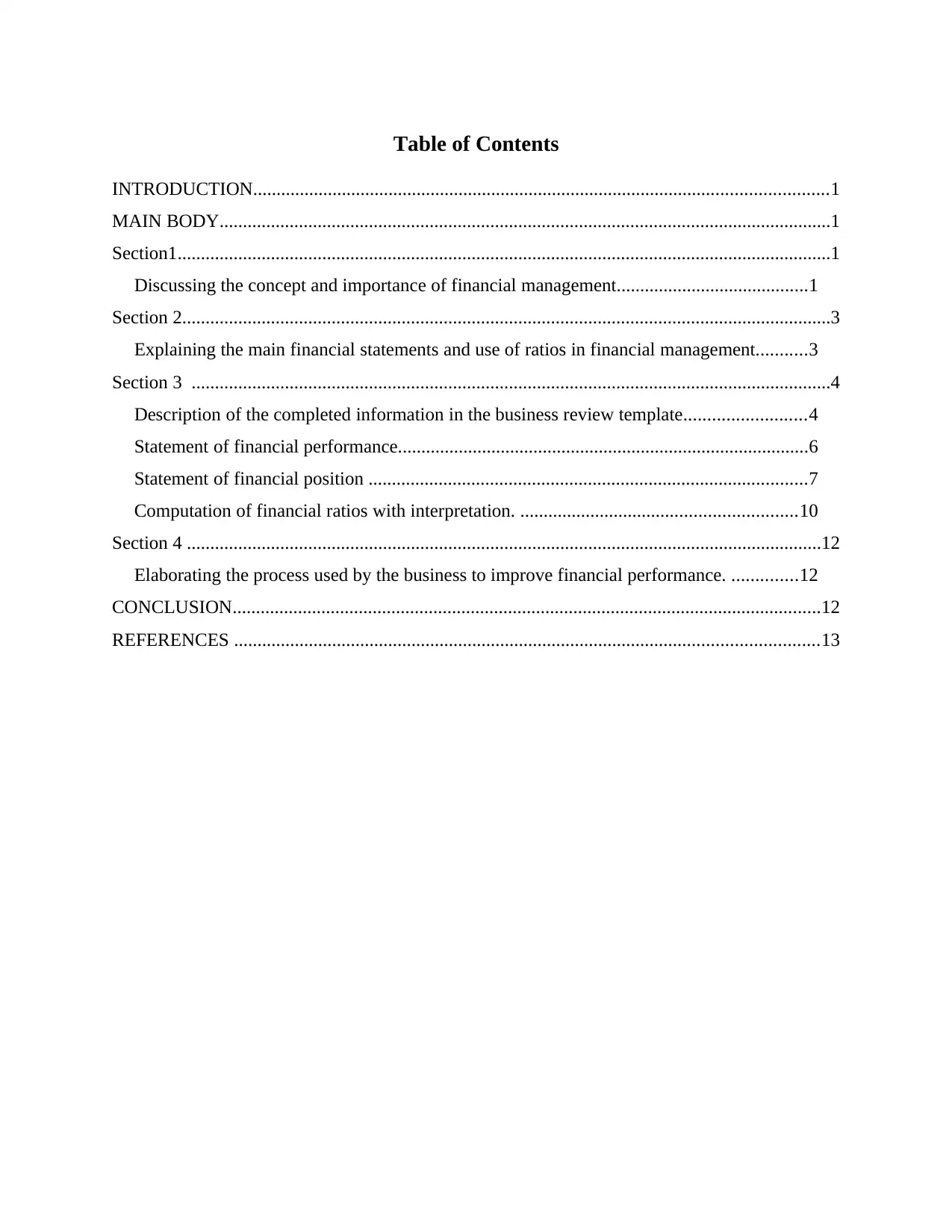
Table of Contents
INTRODUCTION...........................................................................................................................1
MAIN BODY...................................................................................................................................1
Section1............................................................................................................................................1
Discussing the concept and importance of financial management.........................................1
Section 2...........................................................................................................................................3
Explaining the main financial statements and use of ratios in financial management...........3
Section 3 .........................................................................................................................................4
Description of the completed information in the business review template..........................4
Statement of financial performance........................................................................................6
Statement of financial position ..............................................................................................7
Computation of financial ratios with interpretation. ...........................................................10
Section 4 ........................................................................................................................................12
Elaborating the process used by the business to improve financial performance. ..............12
CONCLUSION..............................................................................................................................12
REFERENCES .............................................................................................................................13
INTRODUCTION...........................................................................................................................1
MAIN BODY...................................................................................................................................1
Section1............................................................................................................................................1
Discussing the concept and importance of financial management.........................................1
Section 2...........................................................................................................................................3
Explaining the main financial statements and use of ratios in financial management...........3
Section 3 .........................................................................................................................................4
Description of the completed information in the business review template..........................4
Statement of financial performance........................................................................................6
Statement of financial position ..............................................................................................7
Computation of financial ratios with interpretation. ...........................................................10
Section 4 ........................................................................................................................................12
Elaborating the process used by the business to improve financial performance. ..............12
CONCLUSION..............................................................................................................................12
REFERENCES .............................................................................................................................13
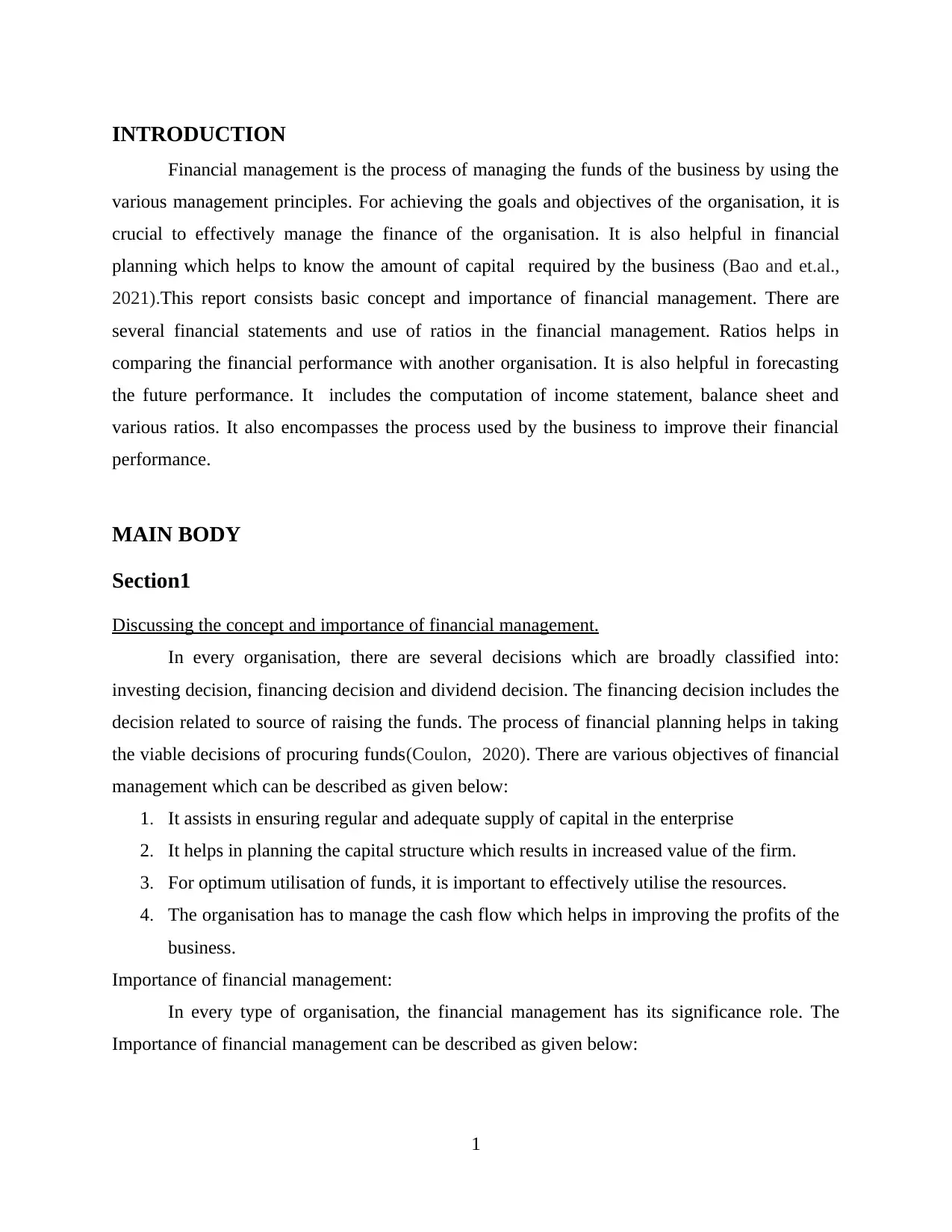
INTRODUCTION
Financial management is the process of managing the funds of the business by using the
various management principles. For achieving the goals and objectives of the organisation, it is
crucial to effectively manage the finance of the organisation. It is also helpful in financial
planning which helps to know the amount of capital required by the business (Bao and et.al.,
2021).This report consists basic concept and importance of financial management. There are
several financial statements and use of ratios in the financial management. Ratios helps in
comparing the financial performance with another organisation. It is also helpful in forecasting
the future performance. It includes the computation of income statement, balance sheet and
various ratios. It also encompasses the process used by the business to improve their financial
performance.
MAIN BODY
Section1
Discussing the concept and importance of financial management.
In every organisation, there are several decisions which are broadly classified into:
investing decision, financing decision and dividend decision. The financing decision includes the
decision related to source of raising the funds. The process of financial planning helps in taking
the viable decisions of procuring funds(Coulon, 2020). There are various objectives of financial
management which can be described as given below:
1. It assists in ensuring regular and adequate supply of capital in the enterprise
2. It helps in planning the capital structure which results in increased value of the firm.
3. For optimum utilisation of funds, it is important to effectively utilise the resources.
4. The organisation has to manage the cash flow which helps in improving the profits of the
business.
Importance of financial management:
In every type of organisation, the financial management has its significance role. The
Importance of financial management can be described as given below:
1
Financial management is the process of managing the funds of the business by using the
various management principles. For achieving the goals and objectives of the organisation, it is
crucial to effectively manage the finance of the organisation. It is also helpful in financial
planning which helps to know the amount of capital required by the business (Bao and et.al.,
2021).This report consists basic concept and importance of financial management. There are
several financial statements and use of ratios in the financial management. Ratios helps in
comparing the financial performance with another organisation. It is also helpful in forecasting
the future performance. It includes the computation of income statement, balance sheet and
various ratios. It also encompasses the process used by the business to improve their financial
performance.
MAIN BODY
Section1
Discussing the concept and importance of financial management.
In every organisation, there are several decisions which are broadly classified into:
investing decision, financing decision and dividend decision. The financing decision includes the
decision related to source of raising the funds. The process of financial planning helps in taking
the viable decisions of procuring funds(Coulon, 2020). There are various objectives of financial
management which can be described as given below:
1. It assists in ensuring regular and adequate supply of capital in the enterprise
2. It helps in planning the capital structure which results in increased value of the firm.
3. For optimum utilisation of funds, it is important to effectively utilise the resources.
4. The organisation has to manage the cash flow which helps in improving the profits of the
business.
Importance of financial management:
In every type of organisation, the financial management has its significance role. The
Importance of financial management can be described as given below:
1
You're viewing a preview
Unlock full access by subscribing today!
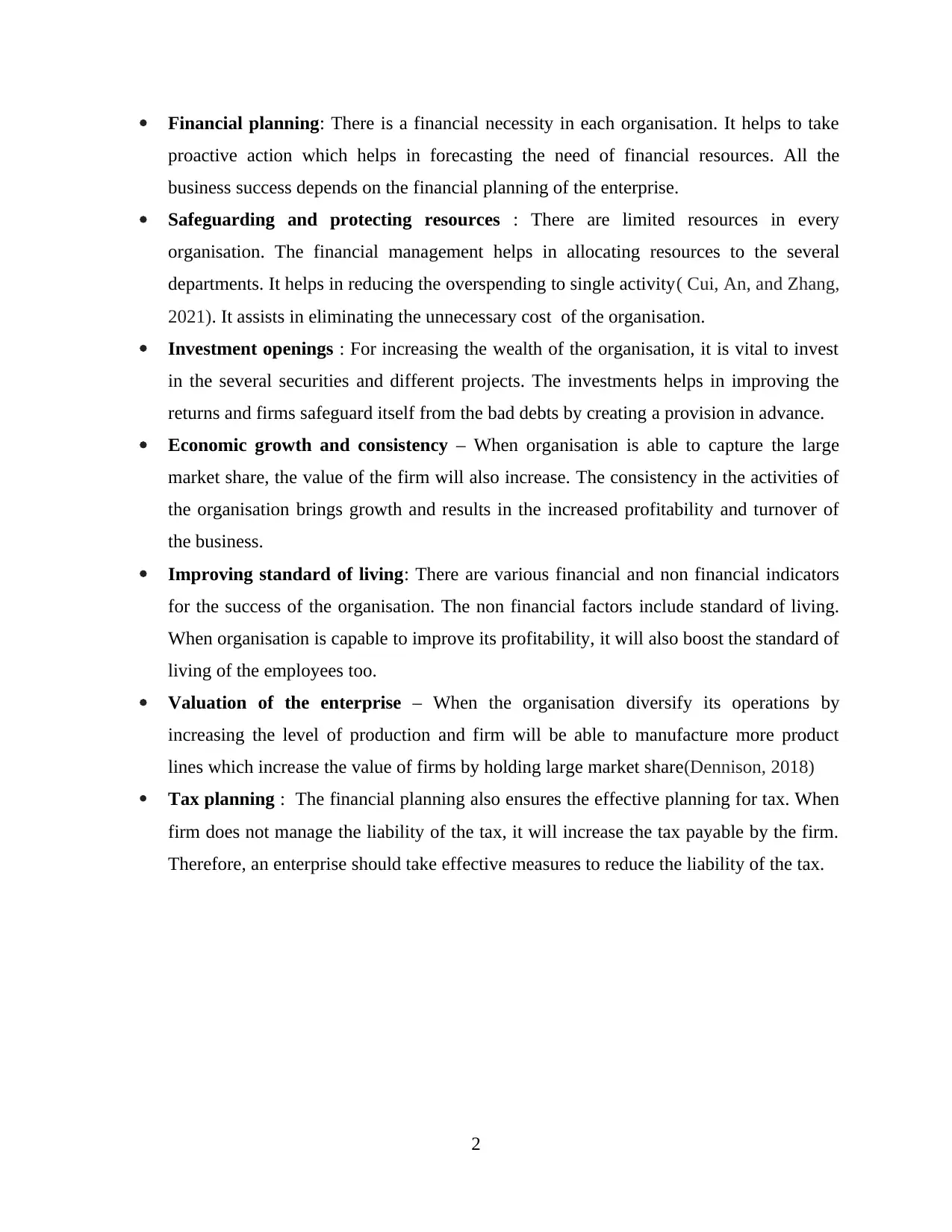
Financial planning: There is a financial necessity in each organisation. It helps to take
proactive action which helps in forecasting the need of financial resources. All the
business success depends on the financial planning of the enterprise.
Safeguarding and protecting resources : There are limited resources in every
organisation. The financial management helps in allocating resources to the several
departments. It helps in reducing the overspending to single activity( Cui, An, and Zhang,
2021). It assists in eliminating the unnecessary cost of the organisation.
Investment openings : For increasing the wealth of the organisation, it is vital to invest
in the several securities and different projects. The investments helps in improving the
returns and firms safeguard itself from the bad debts by creating a provision in advance.
Economic growth and consistency – When organisation is able to capture the large
market share, the value of the firm will also increase. The consistency in the activities of
the organisation brings growth and results in the increased profitability and turnover of
the business.
Improving standard of living: There are various financial and non financial indicators
for the success of the organisation. The non financial factors include standard of living.
When organisation is capable to improve its profitability, it will also boost the standard of
living of the employees too.
Valuation of the enterprise – When the organisation diversify its operations by
increasing the level of production and firm will be able to manufacture more product
lines which increase the value of firms by holding large market share(Dennison, 2018)
Tax planning : The financial planning also ensures the effective planning for tax. When
firm does not manage the liability of the tax, it will increase the tax payable by the firm.
Therefore, an enterprise should take effective measures to reduce the liability of the tax.
2
proactive action which helps in forecasting the need of financial resources. All the
business success depends on the financial planning of the enterprise.
Safeguarding and protecting resources : There are limited resources in every
organisation. The financial management helps in allocating resources to the several
departments. It helps in reducing the overspending to single activity( Cui, An, and Zhang,
2021). It assists in eliminating the unnecessary cost of the organisation.
Investment openings : For increasing the wealth of the organisation, it is vital to invest
in the several securities and different projects. The investments helps in improving the
returns and firms safeguard itself from the bad debts by creating a provision in advance.
Economic growth and consistency – When organisation is able to capture the large
market share, the value of the firm will also increase. The consistency in the activities of
the organisation brings growth and results in the increased profitability and turnover of
the business.
Improving standard of living: There are various financial and non financial indicators
for the success of the organisation. The non financial factors include standard of living.
When organisation is capable to improve its profitability, it will also boost the standard of
living of the employees too.
Valuation of the enterprise – When the organisation diversify its operations by
increasing the level of production and firm will be able to manufacture more product
lines which increase the value of firms by holding large market share(Dennison, 2018)
Tax planning : The financial planning also ensures the effective planning for tax. When
firm does not manage the liability of the tax, it will increase the tax payable by the firm.
Therefore, an enterprise should take effective measures to reduce the liability of the tax.
2
Paraphrase This Document
Need a fresh take? Get an instant paraphrase of this document with our AI Paraphraser
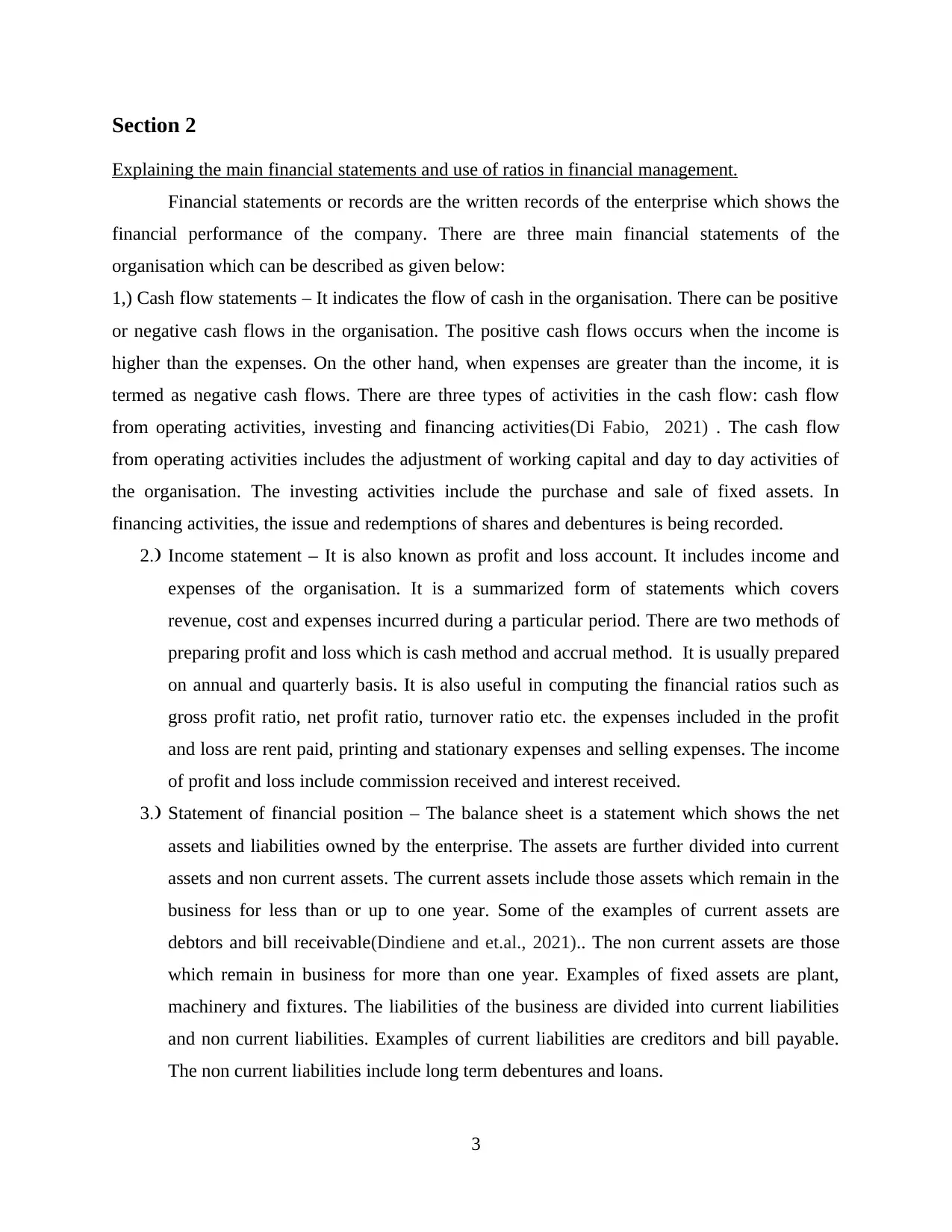
Section 2
Explaining the main financial statements and use of ratios in financial management.
Financial statements or records are the written records of the enterprise which shows the
financial performance of the company. There are three main financial statements of the
organisation which can be described as given below:
1,) Cash flow statements – It indicates the flow of cash in the organisation. There can be positive
or negative cash flows in the organisation. The positive cash flows occurs when the income is
higher than the expenses. On the other hand, when expenses are greater than the income, it is
termed as negative cash flows. There are three types of activities in the cash flow: cash flow
from operating activities, investing and financing activities(Di Fabio, 2021) . The cash flow
from operating activities includes the adjustment of working capital and day to day activities of
the organisation. The investing activities include the purchase and sale of fixed assets. In
financing activities, the issue and redemptions of shares and debentures is being recorded.
2.) Income statement – It is also known as profit and loss account. It includes income and
expenses of the organisation. It is a summarized form of statements which covers
revenue, cost and expenses incurred during a particular period. There are two methods of
preparing profit and loss which is cash method and accrual method. It is usually prepared
on annual and quarterly basis. It is also useful in computing the financial ratios such as
gross profit ratio, net profit ratio, turnover ratio etc. the expenses included in the profit
and loss are rent paid, printing and stationary expenses and selling expenses. The income
of profit and loss include commission received and interest received.
3.) Statement of financial position – The balance sheet is a statement which shows the net
assets and liabilities owned by the enterprise. The assets are further divided into current
assets and non current assets. The current assets include those assets which remain in the
business for less than or up to one year. Some of the examples of current assets are
debtors and bill receivable(Dindiene and et.al., 2021).. The non current assets are those
which remain in business for more than one year. Examples of fixed assets are plant,
machinery and fixtures. The liabilities of the business are divided into current liabilities
and non current liabilities. Examples of current liabilities are creditors and bill payable.
The non current liabilities include long term debentures and loans.
3
Explaining the main financial statements and use of ratios in financial management.
Financial statements or records are the written records of the enterprise which shows the
financial performance of the company. There are three main financial statements of the
organisation which can be described as given below:
1,) Cash flow statements – It indicates the flow of cash in the organisation. There can be positive
or negative cash flows in the organisation. The positive cash flows occurs when the income is
higher than the expenses. On the other hand, when expenses are greater than the income, it is
termed as negative cash flows. There are three types of activities in the cash flow: cash flow
from operating activities, investing and financing activities(Di Fabio, 2021) . The cash flow
from operating activities includes the adjustment of working capital and day to day activities of
the organisation. The investing activities include the purchase and sale of fixed assets. In
financing activities, the issue and redemptions of shares and debentures is being recorded.
2.) Income statement – It is also known as profit and loss account. It includes income and
expenses of the organisation. It is a summarized form of statements which covers
revenue, cost and expenses incurred during a particular period. There are two methods of
preparing profit and loss which is cash method and accrual method. It is usually prepared
on annual and quarterly basis. It is also useful in computing the financial ratios such as
gross profit ratio, net profit ratio, turnover ratio etc. the expenses included in the profit
and loss are rent paid, printing and stationary expenses and selling expenses. The income
of profit and loss include commission received and interest received.
3.) Statement of financial position – The balance sheet is a statement which shows the net
assets and liabilities owned by the enterprise. The assets are further divided into current
assets and non current assets. The current assets include those assets which remain in the
business for less than or up to one year. Some of the examples of current assets are
debtors and bill receivable(Dindiene and et.al., 2021).. The non current assets are those
which remain in business for more than one year. Examples of fixed assets are plant,
machinery and fixtures. The liabilities of the business are divided into current liabilities
and non current liabilities. Examples of current liabilities are creditors and bill payable.
The non current liabilities include long term debentures and loans.
3
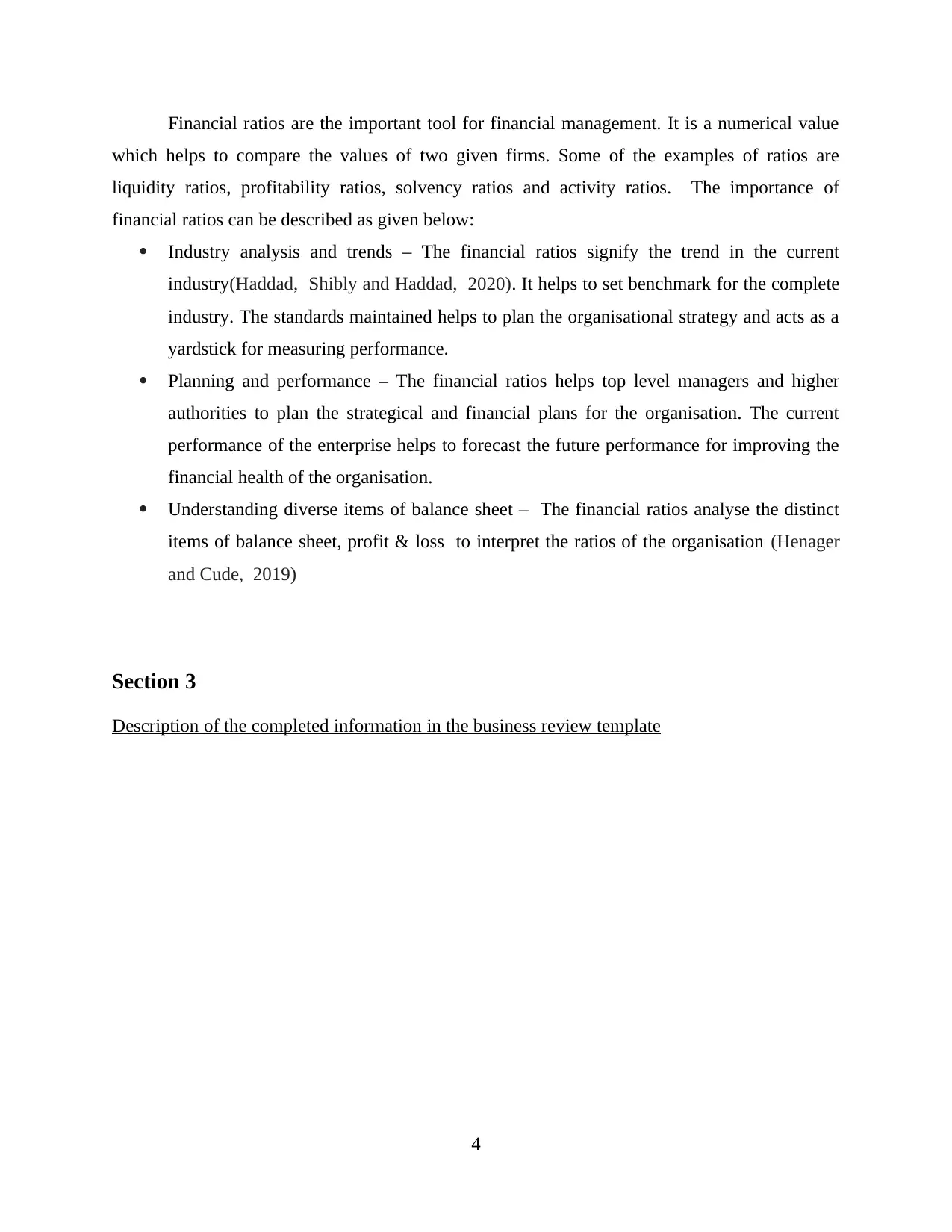
Financial ratios are the important tool for financial management. It is a numerical value
which helps to compare the values of two given firms. Some of the examples of ratios are
liquidity ratios, profitability ratios, solvency ratios and activity ratios. The importance of
financial ratios can be described as given below:
Industry analysis and trends – The financial ratios signify the trend in the current
industry(Haddad, Shibly and Haddad, 2020). It helps to set benchmark for the complete
industry. The standards maintained helps to plan the organisational strategy and acts as a
yardstick for measuring performance.
Planning and performance – The financial ratios helps top level managers and higher
authorities to plan the strategical and financial plans for the organisation. The current
performance of the enterprise helps to forecast the future performance for improving the
financial health of the organisation.
Understanding diverse items of balance sheet – The financial ratios analyse the distinct
items of balance sheet, profit & loss to interpret the ratios of the organisation (Henager
and Cude, 2019)
Section 3
Description of the completed information in the business review template
4
which helps to compare the values of two given firms. Some of the examples of ratios are
liquidity ratios, profitability ratios, solvency ratios and activity ratios. The importance of
financial ratios can be described as given below:
Industry analysis and trends – The financial ratios signify the trend in the current
industry(Haddad, Shibly and Haddad, 2020). It helps to set benchmark for the complete
industry. The standards maintained helps to plan the organisational strategy and acts as a
yardstick for measuring performance.
Planning and performance – The financial ratios helps top level managers and higher
authorities to plan the strategical and financial plans for the organisation. The current
performance of the enterprise helps to forecast the future performance for improving the
financial health of the organisation.
Understanding diverse items of balance sheet – The financial ratios analyse the distinct
items of balance sheet, profit & loss to interpret the ratios of the organisation (Henager
and Cude, 2019)
Section 3
Description of the completed information in the business review template
4
You're viewing a preview
Unlock full access by subscribing today!
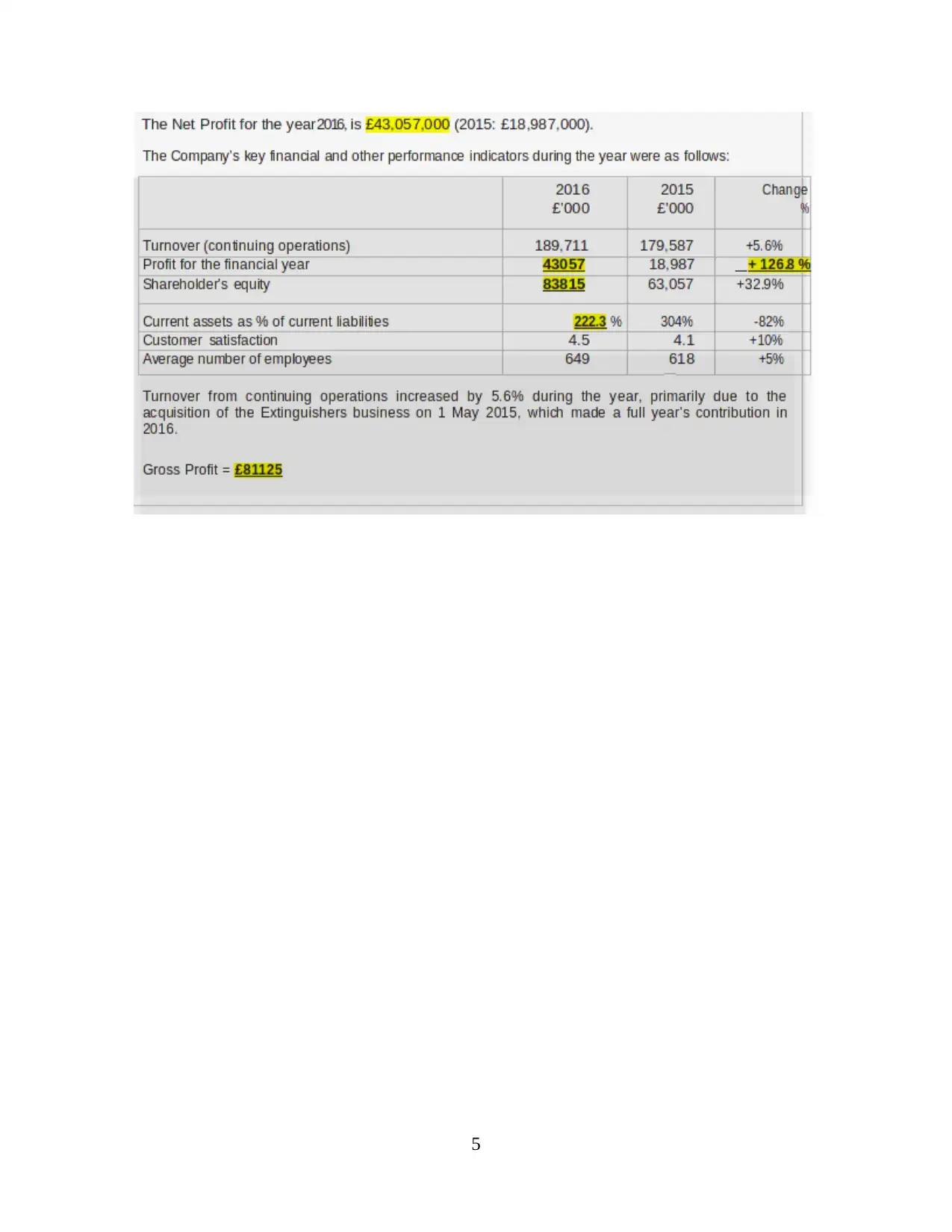
5
Paraphrase This Document
Need a fresh take? Get an instant paraphrase of this document with our AI Paraphraser
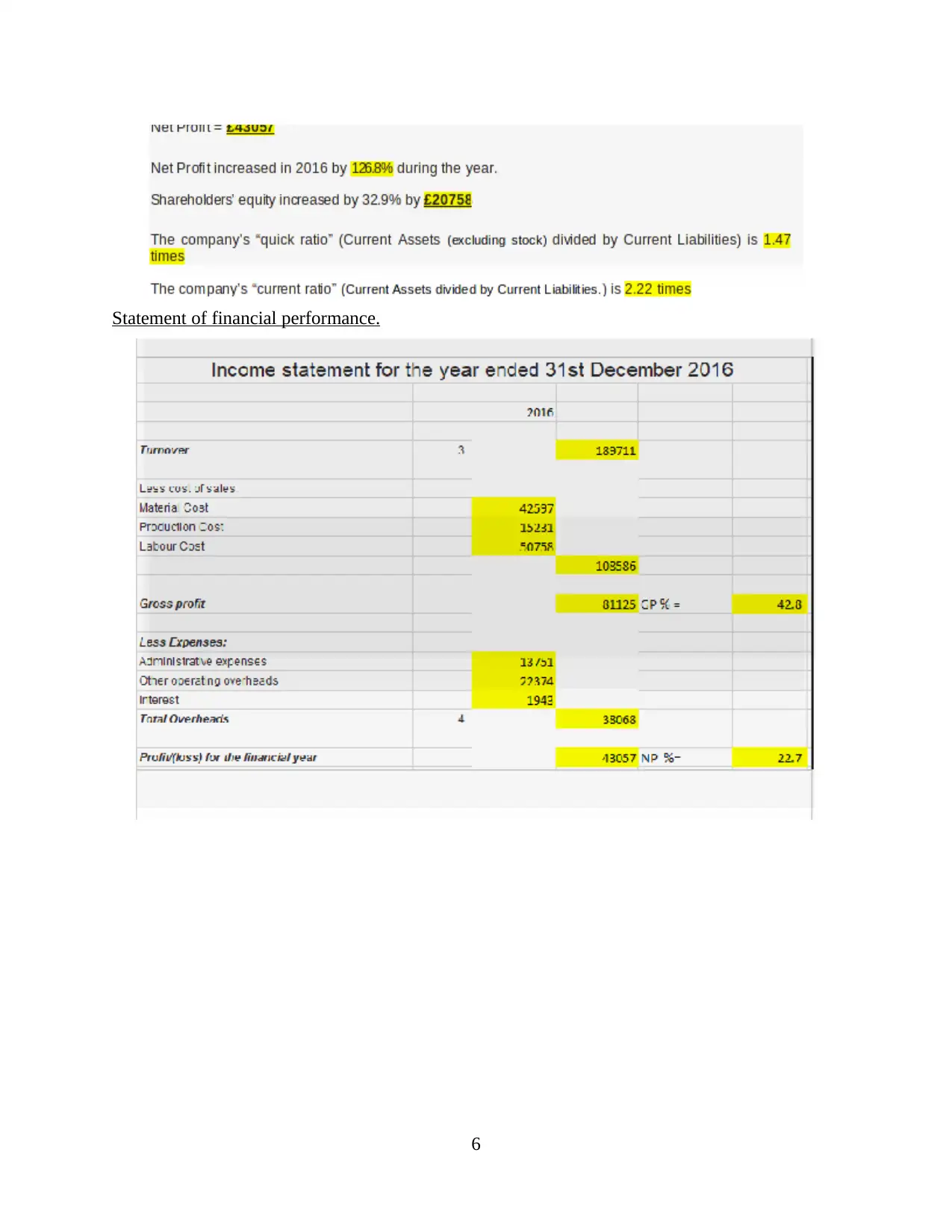
Statement of financial performance.
6
6
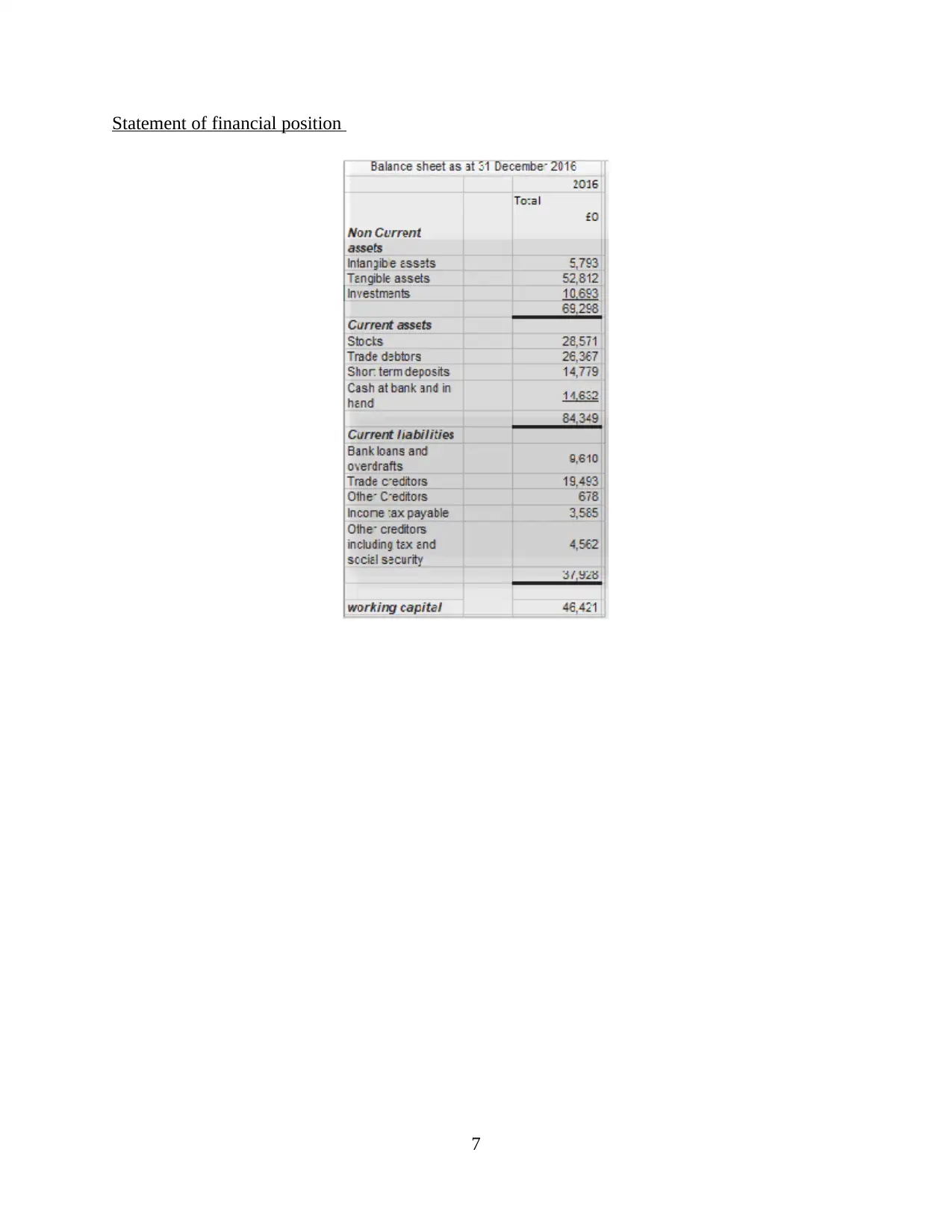
Statement of financial position
7
7
You're viewing a preview
Unlock full access by subscribing today!
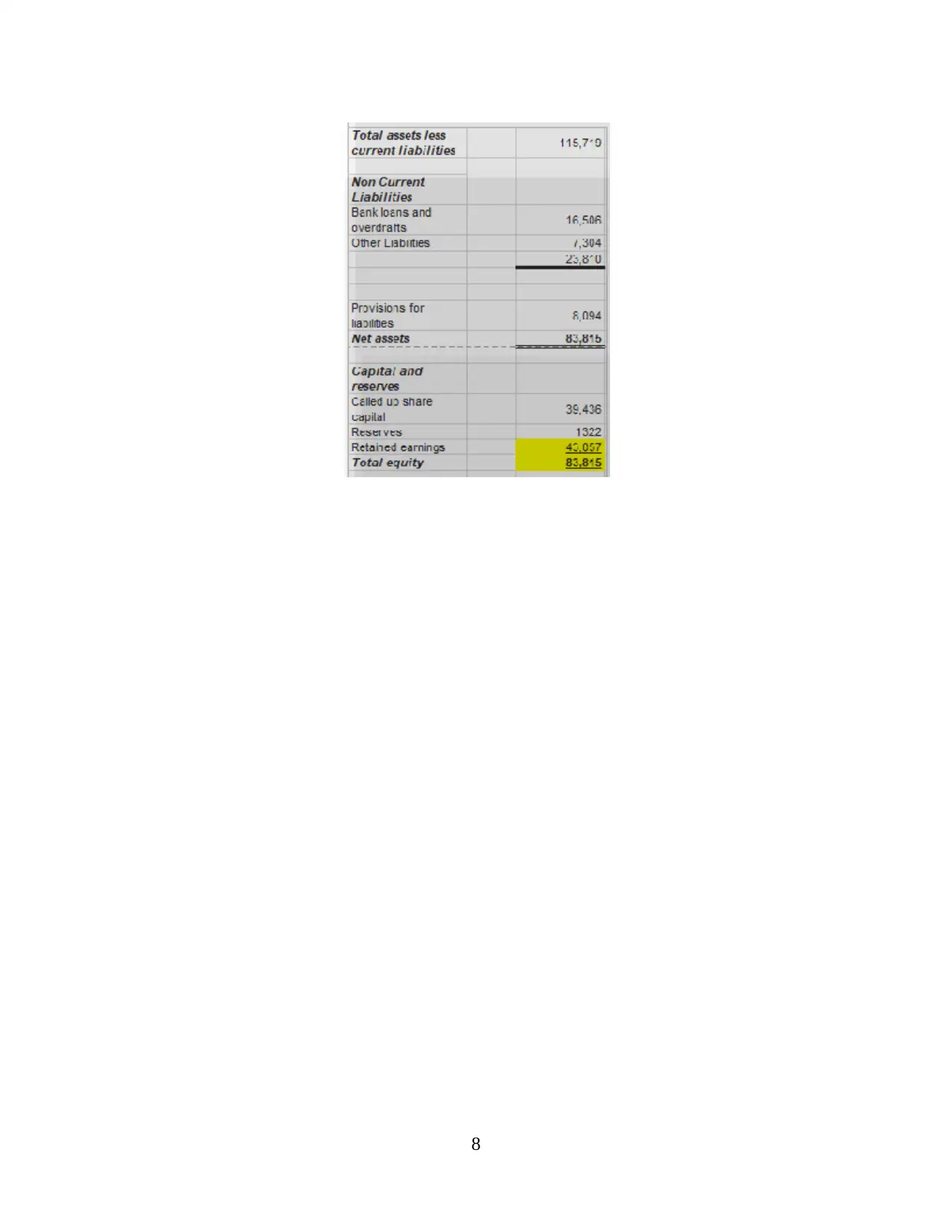
8
Paraphrase This Document
Need a fresh take? Get an instant paraphrase of this document with our AI Paraphraser
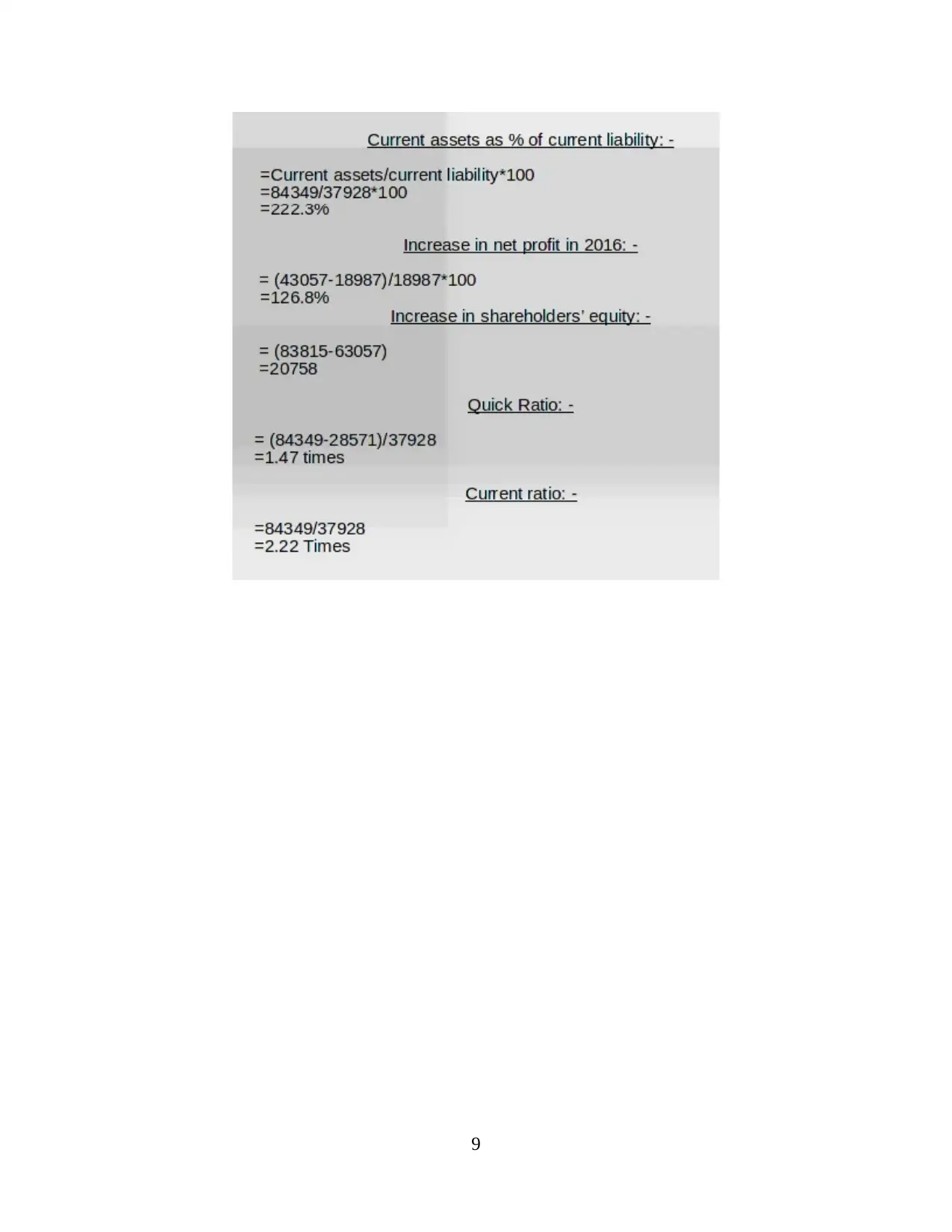
9
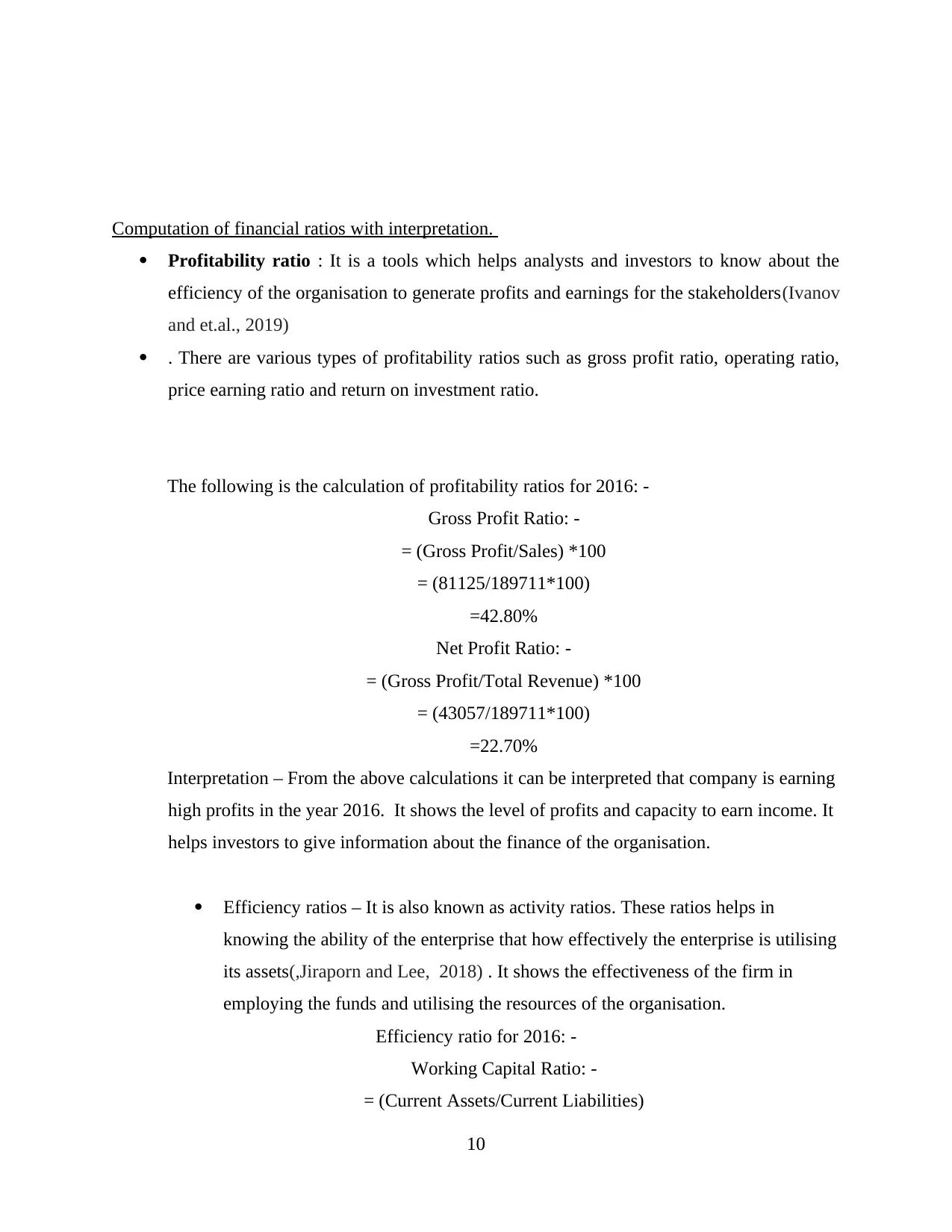
Computation of financial ratios with interpretation.
Profitability ratio : It is a tools which helps analysts and investors to know about the
efficiency of the organisation to generate profits and earnings for the stakeholders(Ivanov
and et.al., 2019)
. There are various types of profitability ratios such as gross profit ratio, operating ratio,
price earning ratio and return on investment ratio.
The following is the calculation of profitability ratios for 2016: -
Gross Profit Ratio: -
= (Gross Profit/Sales) *100
= (81125/189711*100)
=42.80%
Net Profit Ratio: -
= (Gross Profit/Total Revenue) *100
= (43057/189711*100)
=22.70%
Interpretation – From the above calculations it can be interpreted that company is earning
high profits in the year 2016. It shows the level of profits and capacity to earn income. It
helps investors to give information about the finance of the organisation.
Efficiency ratios – It is also known as activity ratios. These ratios helps in
knowing the ability of the enterprise that how effectively the enterprise is utilising
its assets(,Jiraporn and Lee, 2018) . It shows the effectiveness of the firm in
employing the funds and utilising the resources of the organisation.
Efficiency ratio for 2016: -
Working Capital Ratio: -
= (Current Assets/Current Liabilities)
10
Profitability ratio : It is a tools which helps analysts and investors to know about the
efficiency of the organisation to generate profits and earnings for the stakeholders(Ivanov
and et.al., 2019)
. There are various types of profitability ratios such as gross profit ratio, operating ratio,
price earning ratio and return on investment ratio.
The following is the calculation of profitability ratios for 2016: -
Gross Profit Ratio: -
= (Gross Profit/Sales) *100
= (81125/189711*100)
=42.80%
Net Profit Ratio: -
= (Gross Profit/Total Revenue) *100
= (43057/189711*100)
=22.70%
Interpretation – From the above calculations it can be interpreted that company is earning
high profits in the year 2016. It shows the level of profits and capacity to earn income. It
helps investors to give information about the finance of the organisation.
Efficiency ratios – It is also known as activity ratios. These ratios helps in
knowing the ability of the enterprise that how effectively the enterprise is utilising
its assets(,Jiraporn and Lee, 2018) . It shows the effectiveness of the firm in
employing the funds and utilising the resources of the organisation.
Efficiency ratio for 2016: -
Working Capital Ratio: -
= (Current Assets/Current Liabilities)
10
You're viewing a preview
Unlock full access by subscribing today!
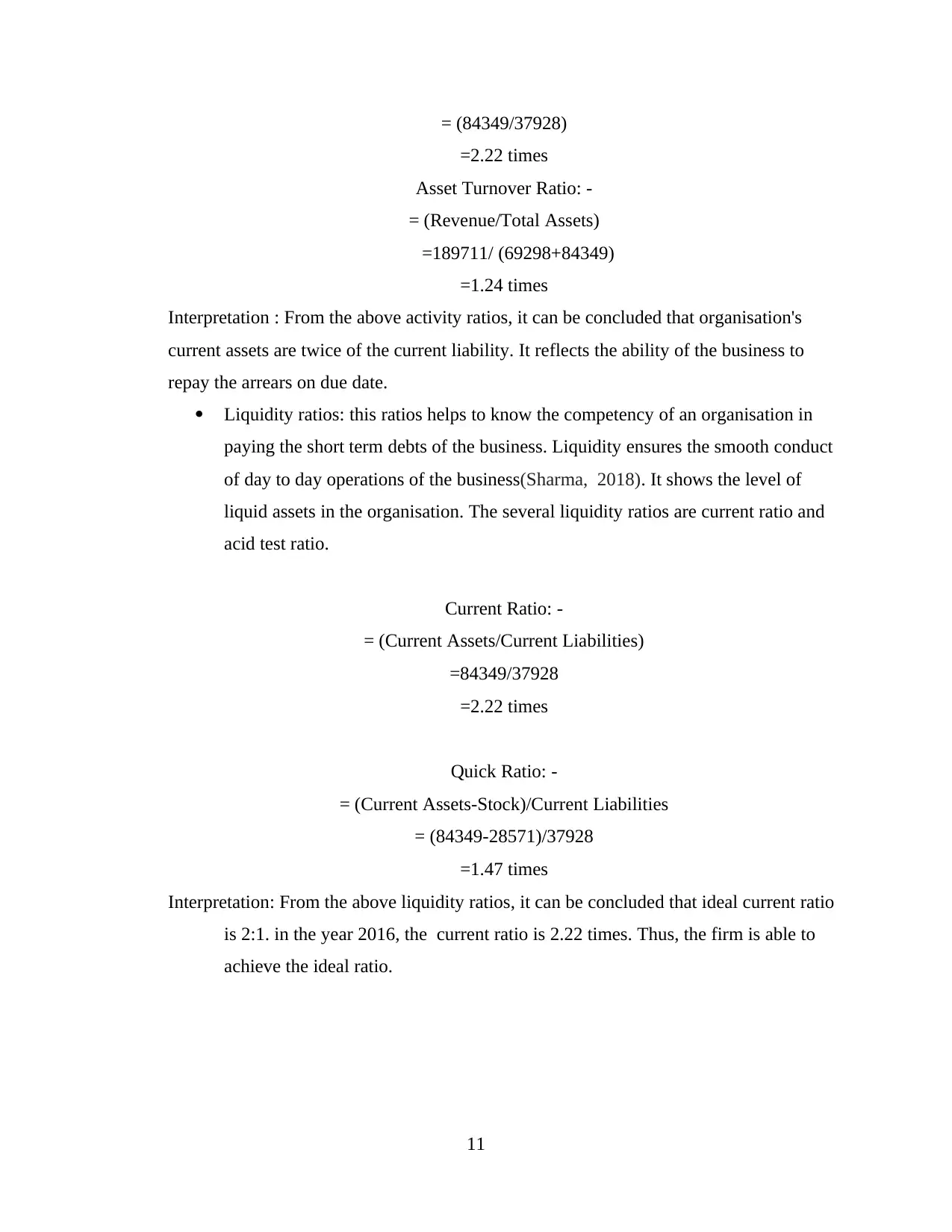
= (84349/37928)
=2.22 times
Asset Turnover Ratio: -
= (Revenue/Total Assets)
=189711/ (69298+84349)
=1.24 times
Interpretation : From the above activity ratios, it can be concluded that organisation's
current assets are twice of the current liability. It reflects the ability of the business to
repay the arrears on due date.
Liquidity ratios: this ratios helps to know the competency of an organisation in
paying the short term debts of the business. Liquidity ensures the smooth conduct
of day to day operations of the business(Sharma, 2018). It shows the level of
liquid assets in the organisation. The several liquidity ratios are current ratio and
acid test ratio.
Current Ratio: -
= (Current Assets/Current Liabilities)
=84349/37928
=2.22 times
Quick Ratio: -
= (Current Assets-Stock)/Current Liabilities
= (84349-28571)/37928
=1.47 times
Interpretation: From the above liquidity ratios, it can be concluded that ideal current ratio
is 2:1. in the year 2016, the current ratio is 2.22 times. Thus, the firm is able to
achieve the ideal ratio.
11
=2.22 times
Asset Turnover Ratio: -
= (Revenue/Total Assets)
=189711/ (69298+84349)
=1.24 times
Interpretation : From the above activity ratios, it can be concluded that organisation's
current assets are twice of the current liability. It reflects the ability of the business to
repay the arrears on due date.
Liquidity ratios: this ratios helps to know the competency of an organisation in
paying the short term debts of the business. Liquidity ensures the smooth conduct
of day to day operations of the business(Sharma, 2018). It shows the level of
liquid assets in the organisation. The several liquidity ratios are current ratio and
acid test ratio.
Current Ratio: -
= (Current Assets/Current Liabilities)
=84349/37928
=2.22 times
Quick Ratio: -
= (Current Assets-Stock)/Current Liabilities
= (84349-28571)/37928
=1.47 times
Interpretation: From the above liquidity ratios, it can be concluded that ideal current ratio
is 2:1. in the year 2016, the current ratio is 2.22 times. Thus, the firm is able to
achieve the ideal ratio.
11
Paraphrase This Document
Need a fresh take? Get an instant paraphrase of this document with our AI Paraphraser
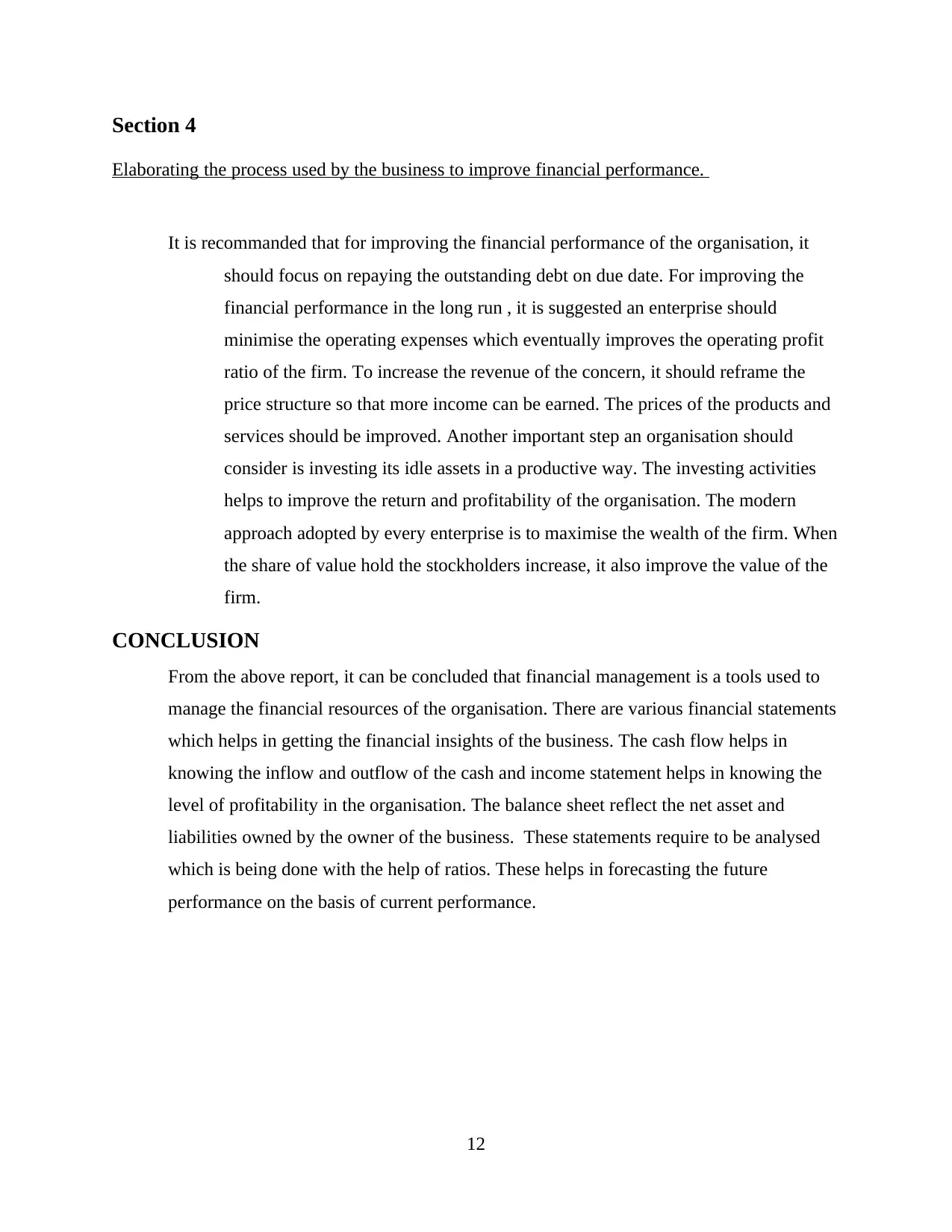
Section 4
Elaborating the process used by the business to improve financial performance.
It is recommanded that for improving the financial performance of the organisation, it
should focus on repaying the outstanding debt on due date. For improving the
financial performance in the long run , it is suggested an enterprise should
minimise the operating expenses which eventually improves the operating profit
ratio of the firm. To increase the revenue of the concern, it should reframe the
price structure so that more income can be earned. The prices of the products and
services should be improved. Another important step an organisation should
consider is investing its idle assets in a productive way. The investing activities
helps to improve the return and profitability of the organisation. The modern
approach adopted by every enterprise is to maximise the wealth of the firm. When
the share of value hold the stockholders increase, it also improve the value of the
firm.
CONCLUSION
From the above report, it can be concluded that financial management is a tools used to
manage the financial resources of the organisation. There are various financial statements
which helps in getting the financial insights of the business. The cash flow helps in
knowing the inflow and outflow of the cash and income statement helps in knowing the
level of profitability in the organisation. The balance sheet reflect the net asset and
liabilities owned by the owner of the business. These statements require to be analysed
which is being done with the help of ratios. These helps in forecasting the future
performance on the basis of current performance.
12
Elaborating the process used by the business to improve financial performance.
It is recommanded that for improving the financial performance of the organisation, it
should focus on repaying the outstanding debt on due date. For improving the
financial performance in the long run , it is suggested an enterprise should
minimise the operating expenses which eventually improves the operating profit
ratio of the firm. To increase the revenue of the concern, it should reframe the
price structure so that more income can be earned. The prices of the products and
services should be improved. Another important step an organisation should
consider is investing its idle assets in a productive way. The investing activities
helps to improve the return and profitability of the organisation. The modern
approach adopted by every enterprise is to maximise the wealth of the firm. When
the share of value hold the stockholders increase, it also improve the value of the
firm.
CONCLUSION
From the above report, it can be concluded that financial management is a tools used to
manage the financial resources of the organisation. There are various financial statements
which helps in getting the financial insights of the business. The cash flow helps in
knowing the inflow and outflow of the cash and income statement helps in knowing the
level of profitability in the organisation. The balance sheet reflect the net asset and
liabilities owned by the owner of the business. These statements require to be analysed
which is being done with the help of ratios. These helps in forecasting the future
performance on the basis of current performance.
12
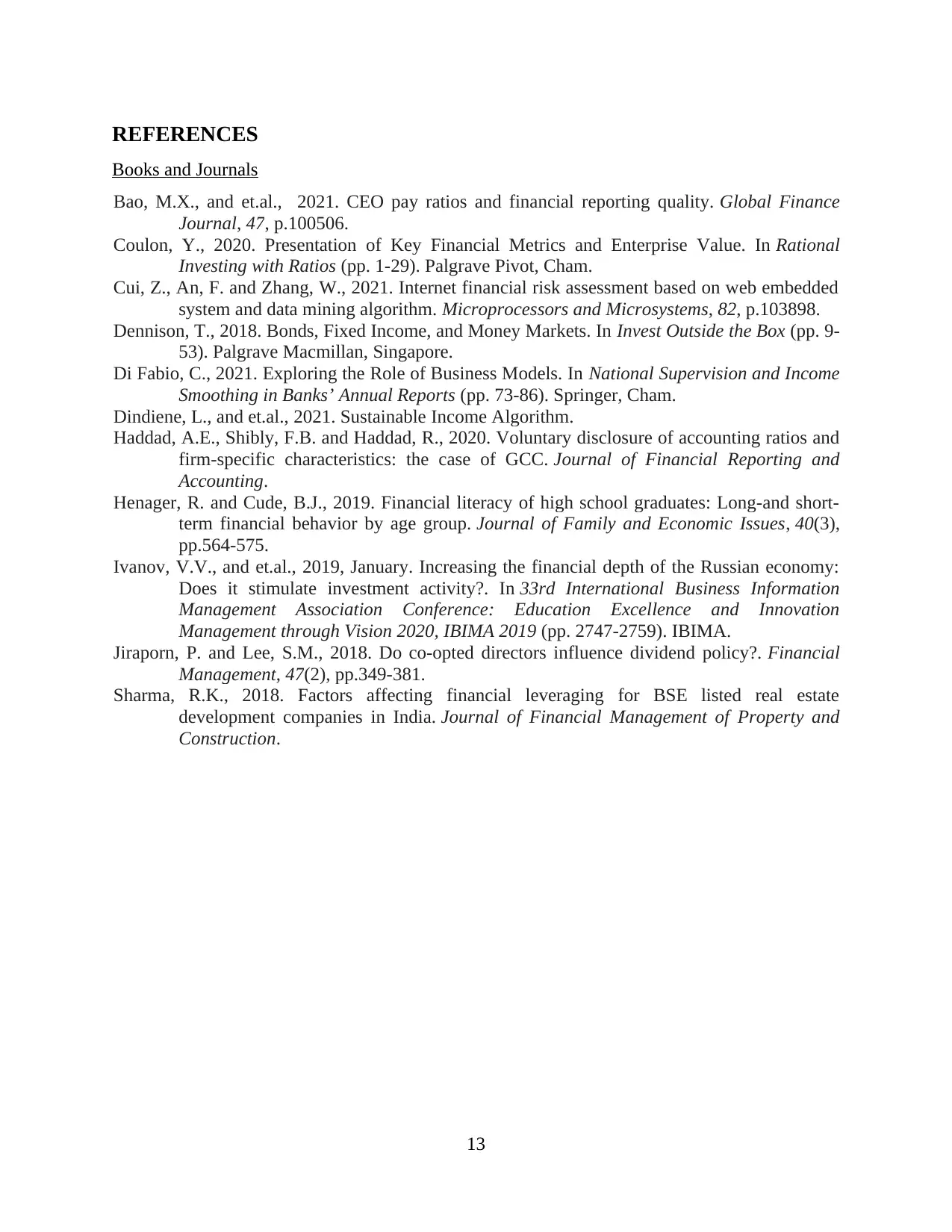
REFERENCES
Books and Journals
Bao, M.X., and et.al., 2021. CEO pay ratios and financial reporting quality. Global Finance
Journal, 47, p.100506.
Coulon, Y., 2020. Presentation of Key Financial Metrics and Enterprise Value. In Rational
Investing with Ratios (pp. 1-29). Palgrave Pivot, Cham.
Cui, Z., An, F. and Zhang, W., 2021. Internet financial risk assessment based on web embedded
system and data mining algorithm. Microprocessors and Microsystems, 82, p.103898.
Dennison, T., 2018. Bonds, Fixed Income, and Money Markets. In Invest Outside the Box (pp. 9-
53). Palgrave Macmillan, Singapore.
Di Fabio, C., 2021. Exploring the Role of Business Models. In National Supervision and Income
Smoothing in Banks’ Annual Reports (pp. 73-86). Springer, Cham.
Dindiene, L., and et.al., 2021. Sustainable Income Algorithm.
Haddad, A.E., Shibly, F.B. and Haddad, R., 2020. Voluntary disclosure of accounting ratios and
firm-specific characteristics: the case of GCC. Journal of Financial Reporting and
Accounting.
Henager, R. and Cude, B.J., 2019. Financial literacy of high school graduates: Long-and short-
term financial behavior by age group. Journal of Family and Economic Issues, 40(3),
pp.564-575.
Ivanov, V.V., and et.al., 2019, January. Increasing the financial depth of the Russian economy:
Does it stimulate investment activity?. In 33rd International Business Information
Management Association Conference: Education Excellence and Innovation
Management through Vision 2020, IBIMA 2019 (pp. 2747-2759). IBIMA.
Jiraporn, P. and Lee, S.M., 2018. Do co‐opted directors influence dividend policy?. Financial
Management, 47(2), pp.349-381.
Sharma, R.K., 2018. Factors affecting financial leveraging for BSE listed real estate
development companies in India. Journal of Financial Management of Property and
Construction.
13
Books and Journals
Bao, M.X., and et.al., 2021. CEO pay ratios and financial reporting quality. Global Finance
Journal, 47, p.100506.
Coulon, Y., 2020. Presentation of Key Financial Metrics and Enterprise Value. In Rational
Investing with Ratios (pp. 1-29). Palgrave Pivot, Cham.
Cui, Z., An, F. and Zhang, W., 2021. Internet financial risk assessment based on web embedded
system and data mining algorithm. Microprocessors and Microsystems, 82, p.103898.
Dennison, T., 2018. Bonds, Fixed Income, and Money Markets. In Invest Outside the Box (pp. 9-
53). Palgrave Macmillan, Singapore.
Di Fabio, C., 2021. Exploring the Role of Business Models. In National Supervision and Income
Smoothing in Banks’ Annual Reports (pp. 73-86). Springer, Cham.
Dindiene, L., and et.al., 2021. Sustainable Income Algorithm.
Haddad, A.E., Shibly, F.B. and Haddad, R., 2020. Voluntary disclosure of accounting ratios and
firm-specific characteristics: the case of GCC. Journal of Financial Reporting and
Accounting.
Henager, R. and Cude, B.J., 2019. Financial literacy of high school graduates: Long-and short-
term financial behavior by age group. Journal of Family and Economic Issues, 40(3),
pp.564-575.
Ivanov, V.V., and et.al., 2019, January. Increasing the financial depth of the Russian economy:
Does it stimulate investment activity?. In 33rd International Business Information
Management Association Conference: Education Excellence and Innovation
Management through Vision 2020, IBIMA 2019 (pp. 2747-2759). IBIMA.
Jiraporn, P. and Lee, S.M., 2018. Do co‐opted directors influence dividend policy?. Financial
Management, 47(2), pp.349-381.
Sharma, R.K., 2018. Factors affecting financial leveraging for BSE listed real estate
development companies in India. Journal of Financial Management of Property and
Construction.
13
You're viewing a preview
Unlock full access by subscribing today!
1 out of 15
Related Documents
Your All-in-One AI-Powered Toolkit for Academic Success.
+13062052269
info@desklib.com
Available 24*7 on WhatsApp / Email
![[object Object]](/_next/static/media/star-bottom.7253800d.svg)
Unlock your academic potential
© 2024 | Zucol Services PVT LTD | All rights reserved.



